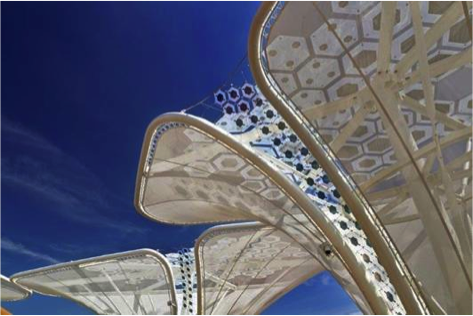[:en]Although “nano”’s unique properties have been commented in number of our past posts, it’s so full of promises that let’s come back to it focusing on the main prospects of nano in solar energy. Nanostructures, nanolayer, nanocomposites, nanotextures used either in the photoactive layers, in other layers, or on the surface of the solar panels are among the different nano-approaches contributing to the multifunctionality required to boost the solar energy field.

In a competitive world of scarce resources, if a nanolayer can be as effective as a conventionally macroscopic one, it is obvious that material saving will be huge resulting generally also in cost saving. Also, as surface-to-volume ratio vary inverse with structure size, the same size of nano-structured solar cells would harvest much more energy than its conventional counterparts.
A recent policy note on thin film photovoltaics (tfPV) teaches us that: “Nanostructures on the front of the PV can guide light into the absorbing layer, or reduce reflection. Nanostructures on the back of a PV could be used as highperformance reflectors, bouncing otherwise lost light back into the PV. The light-absorbing layer itself can benefit from a sculpted nanostructure, which could change its ability to absorb light of different wavelengths, for instance. […] TfPVs also offer additional advantages, besides lower material costs. For example, they are flexible because they only use very thin silicon, whereas current non-thin-film PVs are rigid. This could make tfPVs easier to install; like paper, they could be spooled off a roll. “(1)
In fact this flexibility is a key driver for the increased use of Organic photovoltaics (OPV) for example on the roof of the Expo Milan, an international exhibition which had a high focus on Sustainability (see picture).
The application of nanocoatings is also an interesting prospect for solar panels leading, in an easier way than the creation of an organized nanostructured surfaces, to tailored repellence of liquid and other unwanted substances that deposit on the panel with time. Indeed, typical fouling (dust, dirt, rain, etc.) lead to significant losses of energy harvesting efficiency (up to 40%) and requires frequent maintenance. Therefore, number of initiatives related to their self-cleaning are already on the market. They employ coatings based on nanoparticles, texturation to get lotus effect, or alternatively apply small electrical field to prevent dust from adhering on the surface. In fact, based on nanostructured surfaces, researchers recently developed solar cells that can harvest light from any angle, and lead self-cleaning panels at the same time.
At last, inorganic nanocoatings and nanocomposites are well known to be transparent in the visible range of the spectra to allow harvesting useful light while filtering UV-light potentially resulting in increasing OPVs’ lifetime by their preventing UV weathering.
All in all, the prospects of nano in solar energy are countless, and it has been one of the key drivers contributing to huge energy efficiency enhancement of the solar panels since their creation over 50 years ago. What would YOU consider as main prospects for NANO?
PHOTO: OPV roof of the Expo Milan, picture courtesy of BELECTRIC OPV GmbH
To see more applications of nanotechnology in the PV field at a glance: http://www.understandingnano.com/solarcells.html
source: (1) “Nanotechnology cuts costs and improves efficiency of photovoltaic cells”, Science for Environment Policy, European Commission DG Environment News Alert Service, edited by SCU, The University of the West of England, Bristol.[:]